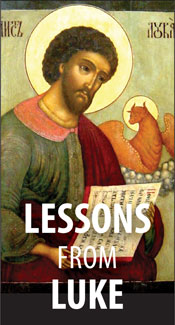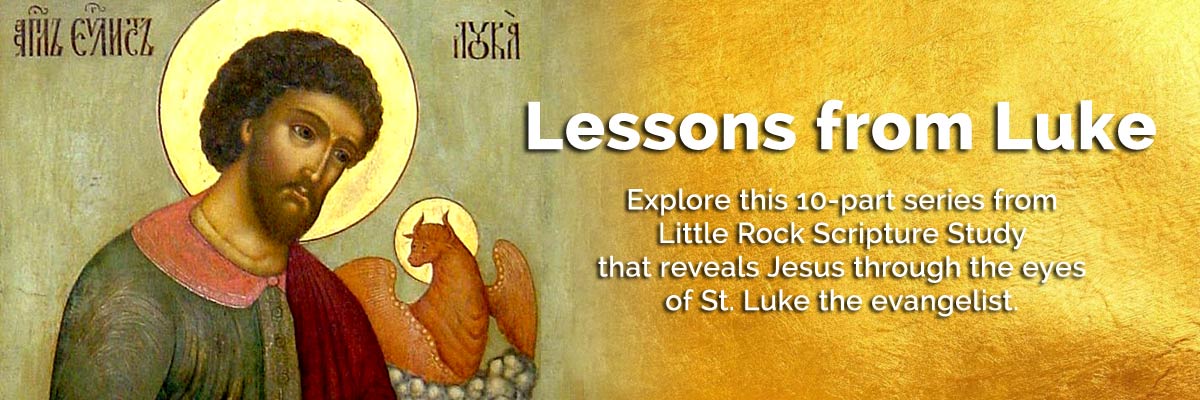Official Website of the
Catholic Diocese of Little Rock
Parables are favored teaching tools
Published: July 20, 2019
This is the sixth column in a 10-part series.
By Cackie Upchurch
Retired Director of Little Rock Scripture Study
Most of us have little trouble identifying our favorite stories from Jesus. These teaching tools that Jesus used frequently are known as parables, and they appear in the Gospels of Matthew, Mark, and Luke. A parable simply puts two things side by side, usually two seemingly different things, and offers a lesson.
 For example, a parable might compare God to a shepherd or a father or a merchant. Or the kingdom of God may be compared to searching for a lost coin. Though familiar sounding to us now, in the normal course of events these are not usually items that fit together — God and shepherds, or kingdoms and lost coins.
For example, a parable might compare God to a shepherd or a father or a merchant. Or the kingdom of God may be compared to searching for a lost coin. Though familiar sounding to us now, in the normal course of events these are not usually items that fit together — God and shepherds, or kingdoms and lost coins.
Parables have a way of grabbing our attention. That grab for attention, disarming the hearer or the reader, is the beauty of a parable. It engages those who hear or read it in a manner that a straightforward command or teaching may not.
Jesus probably learned the art of using parables from his own Jewish tradition. Many of the stories found in the Old Testament are parabolic in nature. For example, the story of Jonah is a lesson about obeying God and extending the news of God even to enemies.
Jonah tried to avoid God’s command to preach to the Ninevites only to be swallowed by a fish and spit out on the shores of the very city where God had tried to send him. It’s a not-so-subtle message about obedience to God. By teaching a lesson in story form with a memorable character and an unlikely series of events, God’s people would have been more likely to wrestle with its truth.
When Jesus told parables, he employed everyday situations (shepherding, traveling, family relationships, household chores) and believable characters (merchants, widows, religious leaders, farmers, bridesmaids) from his own time and place. The stories would have come alive to his immediate audience.
The parables also have meaning beyond their original time and place because they are part of the inspired and living words of Scripture. Our generation, centuries after the time of Jesus, struggles with many of the same things as Jesus’ original followers. Like them, we want to learn to be forgiving, steadfast, just, and merciful; we want to walk the way of generosity and faithfulness; we want to embrace what it means to follow Jesus.
In Luke’s Gospel, which contains the largest collection of Jesus’ parables, the stories occur mainly in chapters 9 through chapter 19. And, many of the parables found only in Luke are among the most beloved and well known. For example, even those who are not students of the Bible or followers of Christ may be familiar with the parables of the Lost Sheep, the Lost Coin, the Lost Son, or the parable of Good Samaritan. There is a definite call in these parables to widen the scope of who is included in the kingdom of God. And this makes sense given the fact that Luke probably wrote his Gospel to a community that was largely Gentile.
The parables often end with an unexpected twist, help us to be open to ongoing transformation. They summon us time and again to contemplate the kingdom of God and what it means to be kingdom people.
Given the fact that the phrase “good Samaritan” has made its way into the normal speech of our culture, usually to describe offering assistance to a stranger in need, we turn our attention to the original story found in Luke 10:29-37. When Jesus is challenged by a Jewish scholar to identify the neighbor we are called to love, he is really being asked “who can we avoid loving?” Jesus cleverly tells the story of a man beaten senseless by robbers as he traveled the route from Jerusalem to Jericho. Jewish religious leaders ignored or even avoided the injured man, but a Samaritan stopped to help him.
People of the time would have known that the Samaritans were the Hatfields to Israel’s McCoys; they suffered a long-standing diet of mutual mistrust. The original listeners would have assumed that helping a Samaritan was not a requirement of love. Their assumption was attached to the kingdom of Israel and its history rather than the kingdom of God. The parable may ask us to help a stranger in need, but even more importantly it asks us to embrace a kingdom that sees no one as stranger.
Study Questions
- When has a story of any kind containing a valuable truth caught your attention and made you think about its lesson more deeply?
- When you think about the parables told by Jesus, which of them tend to prick your conscience, or cause you to pause and see things for clearly?
- Why do you suppose that most of the parables of Jesus are used to teach lessons about the kingdom of God? What is it about this kingdom that defies simply laying out the facts?
- Read the story of the Good Samaritan found in Luke 10:29-37. In what ways do you identify with the characters of the story? What lessons do you find there that apply to living in today’s world?
This article was originally published in Arkansas Catholic July 20, 2019. Copyright Diocese of Little Rock. All rights reserved. This article may be copied or redistributed with acknowledgement and permission of the publisher.




